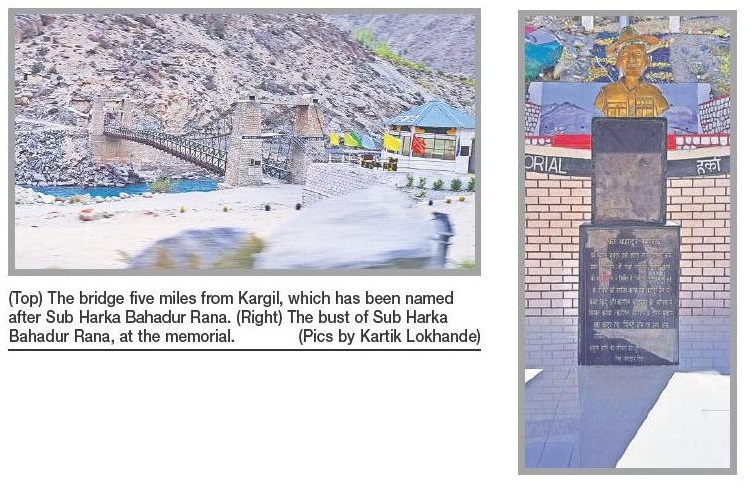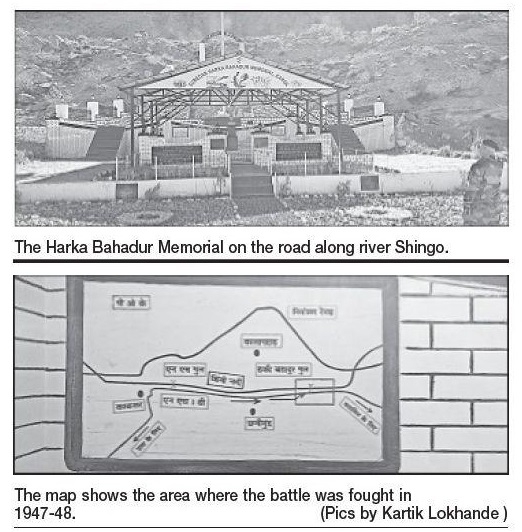THE HERO of 1947-48 How Harka Bahadur secured Kargil
| Date :02-Nov-2023 |

By Kartik Lokhande :
Subedar Harka How Harka Bahadur secured Kargil Bahadur Rana of 1/5 Gorkha Rifles was the man whose supreme sacrifice paved way for the advancement of the Indian forces to wrest Kargil from occupying Pakistani forces and raiders. The capture of Kharal Bridge, 5 miles to Kargil, seemed impossible. But, toughest situations give birth to heroes. Subedar Harka Bahadur was that hero of the moment.
AT A DISTANCE of a
few kilometres from
Kargil, one can
drive along river
Shingo. The blue
sparkling water of the river
offers a mesmerising scene.
Then one comes across a bridge
that connects Kargil Road with
the other side of the river. The
bridge is known as Harka
Bahadur Bridge. Who is this
Harka Bahadur?
Just as this question comes
to one’s mind, one spots a
memorial on the roadside. And,
one gets to know who the man
was. His story also enlightens
one that Kargil’s tryst with wars
with Pakistan dates back to
1947-48. In fact, Subedar Harka
Bahadur Rana of 1/5 Gorkha
Rifles was the man whose
supreme sacrifice paved way
for the advancement of the
Indian forces to wrest Kargil
from the occupying Pakistani
forces and raiders.
For some historic background, in early months of
1947, Maharaja Hari Singh of
Jammu and Kashmir (J&K) initially preferred to sign a
‘Stand still Agreement’ with
both India and Pakistan.
Pakistan readily agreed to it, but
soon its treacherous nature was
exposed. Since September
1947, Pakistan started sending
raiders, tribesmen, irregular
forces into J&K with an obvious intent to occupy it. By midOctober, even the elements of
Pakistani regular Army infiltrated into J&K areas. Alarmed,
finally, Maharaja Hari Singh
signed the ‘Instrument of
Accession’ of J&K to India on
October 26, 1947, pavingthe way for entry of theIndian forces to rid J&K of the
raiders and Pakistan’s military
misadventure.
Irked over this, Pakistan
hatched a conspiracy to initiate aggression to capture J&K
and conceived ‘Operation
Gulmarg’ with an objective to
march towards Srinagar.
Simultaneously, Pakistan also
conspired to annex the Northern Area comprising Gilgit,
Baltistan, and Ladakh during
October-November 1947, that
is, 76 years ago. Major William
Brown,Commander of the Gilgit
Scouts, announced on
November 1 the accession of
Gilgit to Pakistan.Skarduals ofell
to the raiders.

The enemy overwhelmedandcapturedthelightly held garrison of Kargil.
Consequent to the fall of Kargil,
the enemy secured the crucial
Zojilapassatanaltitudeof11,580
ft, a vital link between Ladakh
and Srinagar.
OninductionoftheIndian Air
Force, it was planned to operate
from Leh airfield for capture of
Zojila,Drass,andKargil.1Patiala
made an attempt to advance
through Zojila but was stopped
by the enemyoccupying the key
heights at the pass. The brave
men of 77 Parachute Brigade
under Brigadier KLAtal swung
into action but their attempt
could not succeed because of
insurmountable challenges.
Here,the in genuityof Maj Gen
K S Thimayya, then General
Officer Commanding of 19
Infantry Division, yieldeda daring and unparalleled solution
that enabled the77 Para Brigade
to break through Zojila, and
relieve Drass and Kargil on
November 23, 1948 and gradually restore Srinagar link up with
Leh. On October 29, 1948, &
Cavalry commenced the ascent
to the designated assembly area
irrespectivelyof heavy snowfall.
The Herculean task of getting
the tanks (yes, tanks!) up the
steep winding path with rocky
cliff faces on one side and sheer
depth on the other.This remains
an unparalleled chapter in the
history of tank warfare.
However, there were many stories of heroism till the Indian
forces finally took control of
Kargil and other areas. In several areas, the Indian forces faced
mammoth challenges in terms
of inhospitable terrain, enemy
dominating the heights,chilling
winter,and operating with whatever little resources were available back then. One such story
of daredevilry and overcoming
the odds was scripted in the battle for Khera (also referred to as
Kharal or Kharol in some texts)
Bridge, a few kilometres from
Kargil. It was a crucial link for
advancement of the Indian
troops towards Kargil, but the
enemy was dominating the
heights across Shingo river.
With the advancements after
Zojila, the Indian troops kept
pace in mar chingto wards Kargil.
However, five miles to Kargil,
near Kharal Bridge, they faced a
challenge. The retreating hostiles crossed over the bridge,
burnt it, and moved on to the
higher ground on the other side
of Shingo river. From their positions, they targeted the Indian
troops and stopped them from
advancing towards Kargil. The
chilling winter and enemy fire
presented a tough challenge for
the troops.
The capture of the bridge
seemed to be impossible. The
troops could not keep on fighting the enemy from a distance.
But, toughest of the situations
give birth to heroes. Subedar
Harka Bahadur Rana was that
hero of the moment.
He was
determined that withdrawal or
halt at Kharal Bridge were not
the options if Kargil was to be
secured soon. The troops of 1/5
Gorkha Rifles, part of 77 Para
Brigade, were led by Capt A K
Kochar, CompanyCommander.
As per one account, Capt
Kochar and Subedar Harka
Bahadur Rana swam across the
icy cold waters of Shingo river
and pushed back the enemy
towards what is now the area
jutting a part of Gilgit-Baltistan.
As perthe other, Subedar Harka
Bahadur Rana, the brave JCO of
1/5 Gorkha Rifles, and his team
of determined men surprised
the enemy by crossing the icy
cold Shingo river and leading
the assault on the enemy positions. One can imagine the level of motivation and grit required
to cross a riverin winter at challenging heights andalsoengage
the enemy with out bothering for
own safety.
As per the plaque installed at
the Subedar Harka Bahadur
memorial near the bridge
presently, the brave soldier was
honoured with the Military
Cross. In fact, the memorial has
been built to honour Subedar
Harka Bahadur Rana as well as
‘all those brave men whose cured
this bridge during the Zojilaand
Kargil operations of 1948.
The plaque mentions names
of 14 other men also namely Nk
Sher Bahadur Thapa, Lance Nk
Bhim Bahadur Rana, Lance Nk
Bal Singh Lama, Lance Nk
Kharmal Pun, Lance Nk Padam
Bahadur Aale, Rifleman Kishan
Bahadur Gurud, Rfn Kishan
Bahadur Gurud, Rfn Tam
Bahadur Gurud, Rfn Dag
Bahadur Gurud, Rfn Eja Ghale,
Rfn Harka Bahadur Gurud, Rfn
Jag Bahadur Gurud, Rfn Hastu
Chand, Rfn Dhan Bahadur
Gurud, and Rfn Ran Bahadur
Rana.
There isabust of Subedar
Harka Bahadur Rana under a
shed,and amap showing the significance of the bridge, is painted on a plaque. The memorial
was dedicated to the Indian
Army by Maj Gen SK Khajuria
VSM, GOC,8 Mountain Division,
on August 15, 2009.The memorial was renovated in November
2021.The national tricolour flied
high at the memorial.
The Kharal Bridge has been
reconstructed with stone
columns holding the cables,and
has been renamed as Harka
Bahadur Bridge in honour of the
brave soldier whose daredevilry paved way for advance of the
Indian forces towards Kargil. As
per one reference quoting the
War Diary entry of 1/5 Gorkha
Rifles for November 24, 1948, Lt
Col HS Parab, Major Hari Chand
of 2/8 Gorkha Rifles, 2nd Lt S K
Kaul of 2/4 Gorkha Rifles along
with a small guerrilla party
mounted on ponies had reached
Kargil onthatdate. By that time,
the hostiles had already retreated from Kargil.It completed the
recapture of Kargil and restored
the linkup with Leh.
Though not much is known
about this hero called Subedar
Harka Bahadur Rana, the standing monument in the form of the
bridge will not let people forget
him. Still, a height overlooking
Kargil was illegally occupied by
Pakistan. This troubled the
Indian troops for years to come...
till 1965, at least!
(To be continued)
